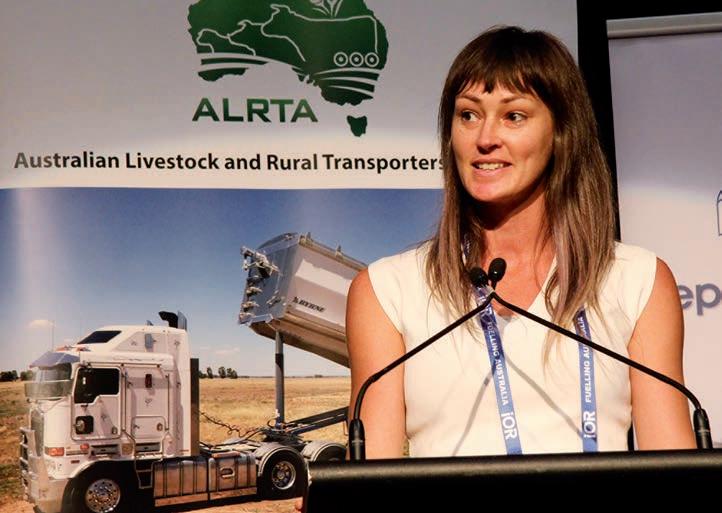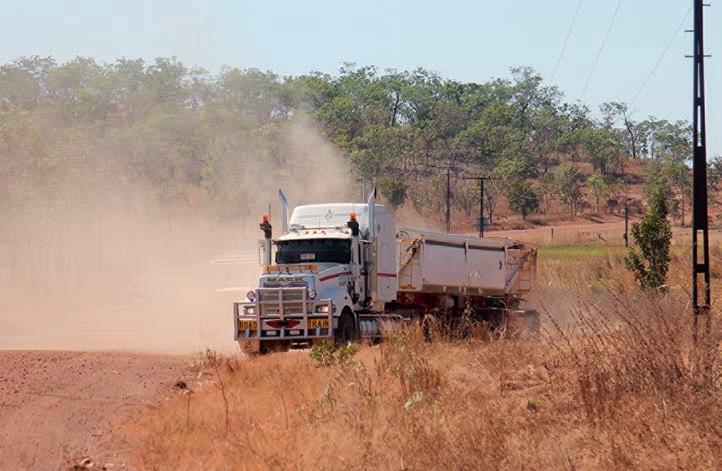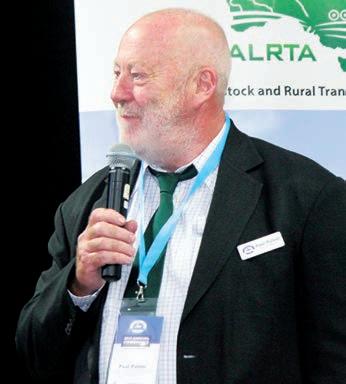
12 minute read
Personality
by Prime Group
NEXT LIFE P R E P A R A T I O N F O R T H E
Bill Gillespie is General Manager of Brand and Franchise Development at Hino Trucks, a role that helps provide him with a special insight into the current truck market.
Damien Scully and Bill Gillespie at truck handover event in 2019.
With over 30 years experience in the automotive industry, Bill Gillespie has held executive positions at Toyota, Nissan, Peugeot and Kia and been involved in motorsport both on and off the track. He joined Hino in 2014 and brings an acute understanding of the customer buying experience as the General Manager of Brand and Franchise Development. Here he offers thoughts on the unique set of challenges affecting the market in these uncommon times.
PM: You’re at the forefront of managing the Hino organisation’s challenges as Australia begins to emerge from the shutdown brought about by COVID-19. How is the impact of the global pandemic affecting the local Hino operation?
BG: Our parts warehouse is still operating so we can continue to offer full parts support to our dealers and our customers. We are still air freighting urgent items in from Japan but there is less air freight due to less planes actually flying. Elsewhere, it’s pretty much business as usual. Obviously we can’t go and see the dealers or our customers face to face but we are doing a lot of contact electronically. Business in that sense is working pretty well, except for lack of personal contact.
PM: How are Hino’s stock levels?
BG: Parts levels are good and vehicle levels are OK. We’ve got to be very careful because trying to forecast the truck market at the moment is a little difficult and we’ve probably got visibility through until the end of June. After that, if business slows then the market may have an uncertain July, August and September
and it might come back again in the fourth quarter, so we have just got to be careful with production orders in terms of what we order for Australia. At this point, we have enough overall stock and stock of individual models. Where it may get difficult is with a couple of models that might just run out faster than everything else. Otherwise I think we are in pretty good shape.
PM: What level of capacity are the Hino factories in Japan operating at?
BG: The plant at Koga, which produces the 500 Series and 700 Series Hino trucks, is operating normally. They are being careful monitoring supply around the world because some of the bigger markets have got a bit slower and they will adjust output accordingly. The 300 Series is produced at the Hamura facility and they produce some Toyota products there as well. They are also still operating normally at this point.
PM: Is the Japanese government providing assistance?
BG: They have a stimulus package similar to ours, albeit on a per capita basis not as large as Australia’s. They have a one trillion yen stimulus package and I think they are trying to retain as much as possible a ‘business as usual’ situation, but there is no doubt automotive manufacturing around the world has been affected in a very serious way. The retail car business has declined badly but the truck business is different because the big customers still need trucks and they realise that in a few months’ time they are going to want new stock. It’s a period of uncertainty and the next 60-90 days are probably going to form what the rest of the year might look like. For most people it will likely affect 2020-21 as well — just how much will depend on how quickly we can get this virus locked down.
PM: Will there be negative effects due to the exchange rates?
BG: Unfortunately the exchange rate between the Australian dollar and the Japanese yen over the last 12 months has dropped 15 per cent. We have
Bill Gillespie.

to try to make some forecasts but it isn’t possible for a factory to keep selling trucks or cars at a price when the currency is devaluing that much. We’ll do our best to try to cushion that over the next six to 12 months, but it certainly will affect the pricing of all Japanese-sourced vehicles.
PM: Can we still expect some new Hino models over the next 18 months?
BG: We have a new 300 Series due later this year. Final timing is being worked on given the current pandemic, but certainly we’re going to start launching pricing and full spec to the market quite soon. And, if things go to plan, the new 700 Series will be launched here in late 2020 and early 2021.
PM: Are they comprehensive changes or mostly cosmetic?
BG: For both models it’s quite a significant step. We’ll have more details later.
PM: Will the changes be as extensive as we’ve seen with the latest 500 Series?
BG: Not so much with the 300 Series but the changes for the 700 Series are definitely as extensive as they were with the 500 Series. Both new products are still on track in terms of production.
BG: The refrigerated delivery business is ‘off the chain’. There’s not even many used ones available and I don’t think it’s going to ease off quickly. We all know that retail has been changing anyway and there are businesses which had bricks and mortar as well as online operations and now they are fully online operations. Some of those businesses are going to say, ‘well, when this finishes do I really want to open up my shop again?’ People are becoming very acclimatised to home delivery of nearly everything and are going to question why they would want to get in their cars and go to a shopping centre.
PM: We’ve witnessed some radical changes in how business operates in Australia. Is it likely to be the same for new trucks?
BG: Our Hino dealers really stood up last year because the market in 2019 got pretty tough. Halfway through that year we pulled our forecast back by a couple of hundred units and we managed to hit that revised number in what wasn’t an easy market.
PM: Considering the first half of the current year, the Hino results from 2019 seem quite good by comparison. Do you agree?
PM: We’re in uncharted waters in 2020. What’s a point of difference for Hino?
BG: Thanks to the new 500 Series Standard Cab, from a fleet perspective we’re winning new business that we haven’t been able to get into previously, due in a large part to the 500’s safety features. In terms of the features and benefits including safety, we have a great product and are gaining some really good fleet sales. Two of our large customers have recently said they couldn’t go past the safety features of the Hino 500 Series Standard Cab. We’ll have to see how Australia bounces back. We’re expecting it to be a ‘V’ shaped recovery rather than a ‘U’ shaped recovery. That’s what we’re banking on. The next 60 days will provide us with a strong indication of the rest of the year’s results.
GATE GOLDEN
Operators of larger road transport vehicles frequently encounter bureaucratic obstacles which deny their access despite such vehicles being capable of physically negotiating the roads leading to and from farming properties. The concept for a restricted farm gate access scheme was initiated by the Livestock, Bulk and Rural Carriers Association of NSW (LBRCA) and has been taken on as a project by Transport for NSW (TfNSW) with the aim to develop a scheme to make it easier to apply for, and approve, safe and legal access for higher productivity vehicles travelling on low volume local roads managed by councils. The framework aligns with the NSW Government’s strategic direction for heavy vehicle access and improving network connectivity. The Farm Gate Access Project has been designed in partnership with peak industry bodies including the LBRCA. The key premise in the entire project is about enabling safer, more productive and legal access for the first and last mile journeys involving rural properties. “We are looking at local roads with limited connectivity: those local low volume roads managed by councils which go to the farm gate,” says Tara McAuley, Just like their metropolitan comrades, rural carriers frequently face challenges in completing the final mile for deliveries or pick-ups at rural properties.
Manager Stakeholder Program Delivery – Freight at TfNSW. “We’re looking at roads that typically see less than 200 vehicles per day, and maybe only 25 of those are heavy vehicles. The kinds of properties we are looking at involve small scale primary production activity, so they only have occasional freight tasks of up to 26 return trips per year, per property. This project is specific to certain vehicle types so we’ve started with restricted access vehicles (RAV) up to, and including, 26 metre B-doubles, vehicles operating at HML, vehicles up to 4.6 metres in height and vehicles under the Livestock Loading or Grain Harvest management schemes. At this stage we are not considering roadtrains.” A tertiary qualified engineer, Tara has been with TfNSW since 2006, back
Tara McAuley.

when it was known as RMS. Tara has represented the state authority at several international transport symposiums and has been an active member of various committees related to diversity and inclusion, Women in Infrastructure and as a regional leader on the NSW Transport Young Professionals Committee. LBRCA President Paul Pulver and LBRCA CEO Bec Coleman represent industry on the project’s steering committee. “If we get caught with the wrong truck on the wrong road the farmer isn’t liable,” says Paul Pulver. “Hopefully this will lead to legalising access that may have been already used for years. We can put safety initiatives in to make it safer in relation to factors such as school buses and speed restrictions.” To get the project underway a third-party
risk assessment tool has been developed with three main elements. “Firstly we have the procedure. This is essentially our end-to-end process of desiring a need for access, to receiving approval for access or otherwise. It calls out the scope, roles and responsibilities, and any risks that are identified in the framework,” says Tara. The next step is a checklist which can be completed online or in hard copy and has been developed with an ease of use in mind. The checklist includes a series of questions, the responses to which determine the level of risk. Risks, once identified, can be mitigated to a lower level depending on the conditions the applicant nominates. “Finally there is the Practitioners’ Guide which is a simple compilation of best practice when completing the assessment and is written with non-technical third parties in mind. The Practitioners’ Guide provides transparency over acceptable and manageable risk,” says Tara. “As a package this works together to give councils confidence that applicants have gone through the correct steps in accordance with Ausroads criteria and using key policy documents to carry out a sound technical route assessment even though the applicant may be of a non-technical background. Essentially what we want to do is package this up and give it to council with your access permit and give them the evidence this is low risk on a low volume road.” The provision to expand the scheme is built into the framework. “If there are many requests for a particular road it pops up an alert and it says there’s obviously a need for access so council let’s have the conversation about increasing access to that road,” Tara explains. The 12 month pilot was launched on June 1, 2019, involving 18 councils and has been essentially about testing the framework to make sure it was fit-forpurpose before a broader roll out across NSW. Both the National Heavy Vehicle Regulator and TfNSW supported the pilot by waiving their fees for applicants. Constructive Solutions, which is a civil engineering and environmental engineering consulting agency, has been engaged by TfNSW to carry out formal evaluations of the project at the six, nine and 12 month stages. “The evaluations are across three stages,” says Tara. “Firstly, about the pilot’s establishment, and understanding the benefits which are available from the project for each of the participating council areas by improving farm access. The second stage is about contacting stakeholders including councils to obtain any relevant data and figuring out where we currently sit within those pilot councils in relation to access. For stage three we are planning on having

Farm Gate aims to improve access for first and last mile journeys on rural properties. Paul Pulver.

two regional workshops with key stakeholders, particularly councils, to bring it together prior to completion of the pilot.” Barriers to success which have so far been identified include the drought and the consequent lower demand for transport, and other natural disasters including bushfires and floods. “Roadtrain access is not part of this project but it may be in the future,” says Tara. “We want to look at incremental access recognising the vehicles we have selected are probably the next step. But we do know some participating councils, such as Moree, are really keen to have this sort of checklist used for roadtrains. Understanding the capacity and ability of some of the bridges and other structures on council roads is a constraint. The LBRCA has been really great about connecting us with some farmers who are keen for access so we’re doing more of that.” According to Tara, the pilot is essentially a risk calculator tool that includes sight distances at intersections. It can be used to demonstrate to councils that a different vehicle is not necessarily less safe in these low risk-low volume situations. “As part of the NSW heavy vehicle access policy framework we very clearly define our strategic direction and what we are after is unlocking the local road network as well as regional and state roads,” Tara says. “We’re also looking at the safety and legality of our access across the network and supporting councils in assisting with their decisions.”










